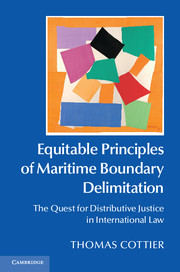 Equitable Principles of Maritime Boundary Delimitation
Equitable Principles of Maritime Boundary Delimitation Book contents
- Frontmatter
- Dedication
- Contents
- List of tables
- List of maps
- Preface
- Acknowledgements
- Table of cases
- Table of treaties and instruments
- Equity revisited: an introduction
- PART I Context: the enclosure of the seas
- PART II The new boundaries
- 4 Approaches to delimitation
- 5 State practice
- 6 Judicial and conciliatory settlements
- 7 An assessment of customary law
- PART III Delimitation based on equity
- Appendix I Maritime boundary agreements 1942–1992
- Appendix II General maps
- Bibliography
- Index
4 - Approaches to delimitation
from PART II - The new boundaries
Published online by Cambridge University Press: 05 May 2015
- Frontmatter
- Dedication
- Contents
- List of tables
- List of maps
- Preface
- Acknowledgements
- Table of cases
- Table of treaties and instruments
- Equity revisited: an introduction
- PART I Context: the enclosure of the seas
- PART II The new boundaries
- 4 Approaches to delimitation
- 5 State practice
- 6 Judicial and conciliatory settlements
- 7 An assessment of customary law
- PART III Delimitation based on equity
- Appendix I Maritime boundary agreements 1942–1992
- Appendix II General maps
- Bibliography
- Index
Summary
The basic dilemma
The establishment of continental shelf zones and exclusive economic zones (EEZs) considerably increased the number and length of the maritime boundaries between coastal states. A 1983 survey identified some 376 international maritime boundaries between 137 coastal states around the globe. In 1988, the US Department of State gave a figure of 412 demarcations required. Eventually, additional boundaries arose due to the advent of new states and the breaking-up of the Soviet Union. Yet another generation of boundaries will result from climate change and accessibility to resources in the Arctic waters. Moreover, many of the already agreed boundaries relate only to the continental shelf and may be subject to review and renegotiation in the context of EEZ delimitation. Given the political and economic sensitivity of international boundary delimitation, guiding rules and principles on the subject remain as essential as before. The task has become even more difficult with the enclosure movement expanding its scope from territorial seas to EEZ and ultimately to continental shelves up to and beyond 200 nautical miles (nm).
Ever since the first attempts to formulate general rules on the subject in the 1930 Hague Codification Conference, and despite a substantial number of publications on the subject, the issue of the appropriate rules and principles applicable to maritime boundary delimitation has remained a controversial issue of the law of the sea. This problem was further aggravated by the enclosure of the seas and the large-scale partitioning of ocean spaces. At the Third United Nations Conference on the Law of the Sea (UNCLOS III), maritime boundary delimitation between coastal states ranked amongst the most difficult and contentious issues. The difficulty has lain in finding and agreeing upon clear and predictable rules of delimitation, which, at the same time, enable justice to be achieved. An old dilemma of law has found yet another example in point.
- Type
- Chapter
- Information
- Equitable Principles of Maritime Boundary DelimitationThe Quest for Distributive Justice in International Law, pp. 179 - 235Publisher: Cambridge University PressPrint publication year: 2015
